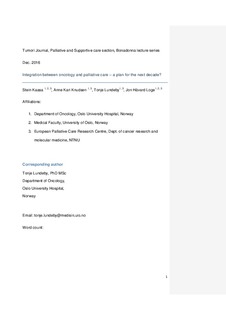| dc.contributor.author | Kaasa, Stein | |
| dc.contributor.author | Knudsen, Anne Kari | |
| dc.contributor.author | Lundeby, Tonje | |
| dc.contributor.author | Loge, Jon Håvard | |
| dc.date.accessioned | 2018-01-29T11:39:33Z | |
| dc.date.available | 2018-01-29T11:39:33Z | |
| dc.date.created | 2017-05-05T12:36:51Z | |
| dc.date.issued | 2017 | |
| dc.identifier.citation | Tumori (Milano). 2017, 103 (1), 1-8. | nb_NO |
| dc.identifier.issn | 0300-8916 | |
| dc.identifier.uri | http://hdl.handle.net/11250/2480240 | |
| dc.description.abstract | With the groundbreaking works of the three Milan professors, i.e. Bonadonna, Veronesi, and Ventafridda, in the 1980’s as the starting point, this article aims to shed light on the potential benefits of a closer and more formal integration between oncology and palliative care. More specifically we will address why integration is needed, how to do it, and what are the potential benefits to the patients, the families and the society.
The costs for cancer care are increasing rapidly. Especially during the last year of life, some treatments are futile and expensive without proven benefit for the patients in terms of prolonged survival with adequate quality of life (QoL). The latest WHO definition of palliative care supports an “upstream” introduction of palliative care. More recent studies indicate that such an early integration has the potential to improve the patients’ QoL and reduce their symptom burden.
Successful integration presupposes formal structures and explicit obligations on how and when to integrate. The Norwegian model for palliative care is presented. It covers the range of oncological and palliative services from community health care via the local hospital to the tertiary hospital and rests on standardised care pathway as the key instrument to promote integration.
Our present state of knowledge indicates that integration does not shorten life, perhaps even the opposite. Futile oncological treatment can be reduced and the QoL of patients and carers improved. We need more evidence on the potential effect upon costs, but present data indicate that integration does not increase them. | nb_NO |
| dc.language.iso | eng | nb_NO |
| dc.publisher | Wichtig | nb_NO |
| dc.title | Integraton between oncology and palliatve care: A plan for the next decade? | nb_NO |
| dc.type | Journal article | nb_NO |
| dc.type | Peer reviewed | nb_NO |
| dc.description.version | acceptedVersion | nb_NO |
| dc.source.pagenumber | 1-8 | nb_NO |
| dc.source.volume | 103 | nb_NO |
| dc.source.journal | Tumori (Milano) | nb_NO |
| dc.source.issue | 1 | nb_NO |
| dc.identifier.doi | 10.5301/tj.5000602 | |
| dc.identifier.cristin | 1468424 | |
| dc.description.localcode | © 2017. This is the authors' accepted and refereed manuscript to the article. The final authenticated version is available online at: http://www.tumorijournal.com/article/cfa67d43-4ea2-4918-a95e-635d6ff95831 | nb_NO |
| cristin.unitcode | 194,65,15,0 | |
| cristin.unitcode | 194,65,0,0 | |
| cristin.unitname | Institutt for klinisk og molekylær medisin | |
| cristin.unitname | Fakultet for medisin og helsevitenskap | |
| cristin.ispublished | true | |
| cristin.fulltext | preprint | |
| cristin.qualitycode | 1 | |
